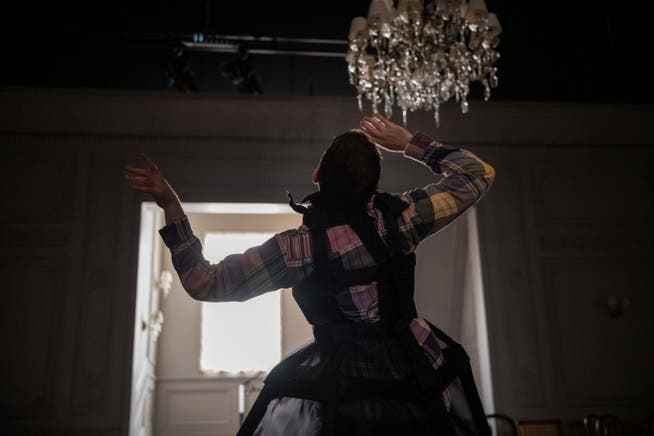At the Zurich Schauspielhaus, director Trajal Harrell takes Bernarda Alba and her daughters to the Dior home. They turn it on its head with Voguing and Butoh.
The «dernier Cri» is drowned out by a silent scream in Trajal Harrell’s «House of Bernarda Alba».
We are a handpicked company and we have the choice: velvet or tapestry. We are talking about the upholstery of the beautiful old chairs in the house of Dior. We can relate this to the fact that we attend one of those exclusive fashion shows that the beautiful and rich were allowed to experience in Paris in the late 1940s. The models weren’t yet walking the catwalk, but rather presenting Dior’s “New Look” to the audience in the salon up close.
And so we sit around the show area and wait for the beautiful women in magical dresses. But when they step through one of the four doors, they are wearing tracksuits. And white aprons. And they sing the song to the unsung heroines of haute couture, «Les Petites Mains», who craft the splendor with incredible skill. Then the industrious show us the lace fabrics and hold the lengths of fabric against the body. This is the ultimate in elegance that we will experience this evening.
appropriation of another kind
Bernarda Alba and her daughters are in vogue here, and their fashion is pitch black. Chic leather belts become their dreadlocks and wondrous blouses become headscarves. Whatever splendor has found on their heads and bodies, it crushes them to the ground. This is a different kind of cultural appropriation: as a parody of the flourishing world of fashion by means of deconstruction, which is in turn being deconstructed here before our eyes.
Because we are not sitting in the Maison Dior of the late 1940s, but in the Zurich Schauspielhaus, where Trajal Harrell and the set designer Erik Flatmo have recreated the Dior Salon. And the American choreographer and resident director at the Schauspielhaus does not send the «dernier Cri» on parade through the salon, but a pain-distorted, silent scream. «But she, Bernarda Alba’s youngest daughter, died untouched. did you understand me you have to be silent. I said silence. Be silent!” These are Bernarda’s last words in Federico García Lorca’s 1936 play “Bernarda Alba’s House”. He was murdered by the Falangists shortly after its completion.
Bernarda’s house is a women’s prison, decreed by the mother after the death of the father. Only the eldest of the five daughters is allowed to marry, the others are to stay in the house and mourn for eight years. But the youngest gives herself to her sister’s bridegroom and hangs herself because she thinks Bernarda shot him. That’s drama for the ballet, and the material has always found its way onto the dance stage. Mats Ek’s early work “Bernarda” from 1978 became world famous.
In «The House of Bernarda Alba», Trajal Harrell invites the widow and her household into the salon of the house of Dior. In doing so, he follows the tradition of balls from the African American and Latin American gay and trans communities in New York, where the dance style voguing originated. In the voguing scene, the “houses” are alternative family communities. They offer protection for the marginalized and the persecuted, and they bear the names of famous fashion houses such as Dior, Gucci or Mugler
end of an age
But on the peacock stage, the house of Dior offers Bernarda’s daughters and maids no protection. They may first have a bit of fun with Lula Pena’s fado, the two of them find each other under the crinoline. Then Trajal Harrell enters and dances the Dance of the Trembling Fingers. Piano and violin from Giya Kancheli’s “Time… And Again” now take over the tone and the Japanese butoh does the dancing. The bodies of the performers are writhing, their limbs twisted inwards, their faces painted white, their mouths twisted, drooling – it has been a long time since Trajal Harrell has seen so much butoh in his plays.
The choreographer has been mixing voguing with the dance theater form from post-war Japan for a long time. But in recent years the butoh has seemed to be sitting deeper in the body – and disrupting the catwalk from there. Here it is external and internal power at the same time, a power that drives these people before them, not only as a sign of suppressed sexuality, but as a prevention per se – and as a dance of death. We sit on velvet or tapestry, an exclusive community invited to the elegant House of Dior at the dawn of a new age. And we see how this age is buried, how people bury themselves in it and with them the belief in a future somewhere in this world.

